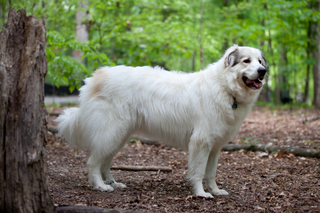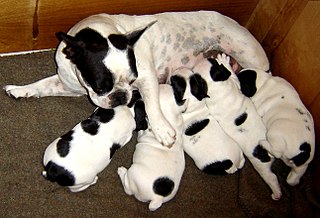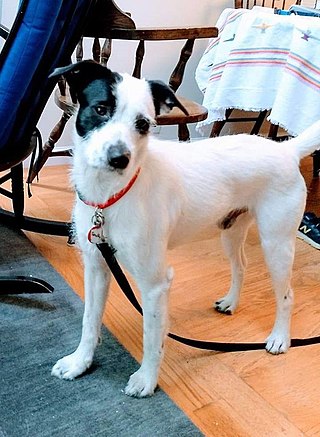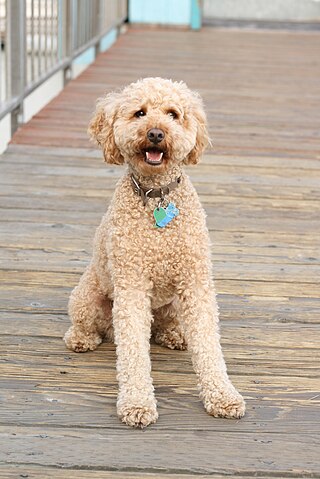
The Pharaoh Hound or Kelb tal-Fenek is a Maltese breed of hunting dog. It is traditionally used for rabbit-hunting in the rocky terrain of the islands; the Maltese name means "rabbit dog".

A dog breed is a particular strain of dog that was purposefully bred by humans to perform specific tasks, such as herding, hunting, and guarding. Dogs are the most variable mammal on Earth, with artificial selection producing around 450 globally recognized breeds. These breeds possess distinct traits related to morphology, which include body size, skull shape, tail phenotype, fur type, body shape, and coat colour. Their behavioral traits include guarding, herding, and hunting, and personality traits such as hyper-social behavior, boldness, and aggression. Most breeds were derived from small numbers of founders within the last 200 years. As a result, today dogs are the most abundant carnivore species and are dispersed around the world.

A Schipperke is a small breed of dog that is believed to have originated in the 1600s in Belgium. There has been a long informal debate over whether this type of dog is a spitz or miniature sheepdog. In their home country of Belgium they are considered a small shepherd. DNA research has shown that Schipperkes have a close relationship to the Spitz family of dog breeds.

The Pyrenean Mountain Dog is a French breed of livestock guardian dog; in France it is commonly called the Patou. It originates from the eastern or French side of the Pyrenees Mountains that separate France and Spain. It is recognised as a separate breed from the Mastín del Pirineo or Pyrenean Mastiff from the Spanish side of the mountains, to which it is closely related.

Dog breeding is the practice of mating selected dogs with the intention of maintaining or producing specific qualities and characteristics. When dogs reproduce without such human intervention, their offspring's characteristics are determined by natural selection, while "dog breeding" refers specifically to the artificial selection of dogs, in which dogs are intentionally bred by their owners. Breeding relies on the science of genetics, hence a breeder who is knowledgeable on canine genetics, health, and the intended purpose of the dogs attempts to breed suitable dogs.

A mongrel, mutt or mixed-breed dog is a dog that does not belong to one officially recognized breed and including those that are the result of intentional breeding. Although the term mixed-breed dog is sometimes preferred, many mongrels have no known purebred ancestors. Crossbreed dogs, and "designer dogs", while also a mix of breeds, differ from mongrels in being intentionally bred. At other times, the word mongrel has been applied to informally purpose-bred dogs such as curs, which were created at least in part from mongrels, especially if the breed is not officially recognized.

The Bergamasco Shepherd, Italian: Cane da Pastore Bergamasco, is an Italian breed of sheepdog. It originated in the Alpi e Prealpi Bergamasche, where it was used as a herding dog for both sheep and cattle.

A crossbreed is an organism with purebred parents of two different breeds, varieties, or populations. Crossbreeding, sometimes called "designer crossbreeding", is the process of breeding such an organism. While crossbreeding is used to maintain health and viability of organisms, irresponsible crossbreeding can also produce organisms of inferior quality or dilute a purebred gene pool to the point of extinction of a given breed of organism.

A landrace is a domesticated, locally adapted, often traditional variety of a species of animal or plant that has developed over time, through adaptation to its natural and cultural environment of agriculture and pastoralism, and due to isolation from other populations of the species. Landraces are distinct from cultivars and from standard breeds.

The Cirneco dell'Etna is an Italian breed of hunting dog from the Mediterranean island of Sicily. It is named for the Etna volcano in eastern Sicily. It has a keen sense of smell, and is used to hunt small game, particularly rabbits. As with many working dogs, registration is conditional on successful completion of a working trial.

The Berger Picard or Picardy Shepherd, is a French herding dog originating in Picardy. These dogs nearly became extinct after both World War I and World War II and remain a rare breed.

Podenco Canario is a breed of dog from the Canary Islands. The Podenco Canario is still used today, primarily in packs, most often for the sport hunting of rabbits. The word "podenco" in Spain refers to a certain type of dog, typically rabbit hunters with the same body shape. "Canario" is a reference to its region of origin, the Canary Islands. The Spanish Kennel Club, Real Sociedad Canina de España, recognises the following similar dog breeds that use the identifier "podenco" in their names: Podenco Andaluz, Podenco Ibicenco, and Podenco Valenciano. ge

The Karst Shepherd is a breed of dog of the livestock guardian type, originating in Slovenia. This breed is recognised by the Fédération Cynologique Internationale.

The Lupo Italiano is a dog breed from Italy. According to its creator, the breed's foundation was a wolf hybrid produced from crossing a German Shepherd and an Italian wolf, though a number of genetic studies put this in doubt.

The Cane Paratore is a breed of herding dog from Italy, the breed primarily exists in its traditional role in Abruzzo, its historical region of origin, having not gained popularity from outside dog fanciers.

The Podenco Andaluz is an ancient Spanish breed of warren hound used to hunt small game in Andalusia, Spain. It is one of four podenco breeds recognized by the Real Sociedad Canina de España. It is an agile dog generally used to hunt ducks, rabbits, boar and fowl. There are three accepted sizes and three coat types.

The Argentine Pila is an Argentine breed of hairless dog. It is recognised by the Asociación Canina Argentina. It is one of a small number of hairless dog breeds; others include the African hairless dog, the American Hairless Terrier, the Chinese Crested Dog, the Hairless Khala of Bolivia, the Peruvian Inca Orchid and the Xoloitzcuintle or Mexican Hairless.

Dogs have a wide range of coat colors, patterns, textures and lengths. Dog coat color is governed by how genes are passed from dogs to their puppies and how those genes are expressed in each dog. Dogs have about 19,000 genes in their genome but only a handful affect the physical variations in their coats. Most genes come in pairs, one being from the dog’s mother and one being from its father. Genes of interest have more than one expression of an allele. Usually only one, or a small number of alleles exist for each gene. In any one gene locus a dog will either be homozygous where the gene is made of two identical alleles or heterozygous where the gene is made of two different alleles.

The Pastore della Lessinia e del Lagorai is an old Italian dog breed from the northeastern region called Triveneto. It is not recognized by any major kennel organisation.



















